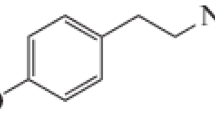Abstract
Key factors influencing the analyte detection limit of the sandwich immunochromatographic assay (ICA), namely, the size of gold nanoparticles, the antibody concentration, the conjugation pH, and characteristics of membranes, are discussed. The impacts of these factors were quantitatively characterized and compared for the first time using the same antigen (potato virus X). The antibody–colloidal gold conjugates synthesized at pH 9.0–9.5 (the pH was examined in the range from 7.5 to 10.0) and at an antibody concentration of 15 μg/mL (the concentration was tested from 10 to 100 μg/mL) demonstrated maximum binding with the analyte. The relationship between the size of gold nanoparticles and the ICA detection limit was determined. The detection limit decreases from 80 to 3 ng/mL (for antibodies with K D = 1.0 × 10-9 M, data were obtained using a BIAcore X instrument) for a series of particles with a diameter from 6.4 to 33.4 nm (electron microscopy and dynamic light scattering data). In the case of larger particles (52 nm in diameter), the detection limit increases and reaches 9 ng/mL. A 10 mM phosphate buffer, pH 8, and a 50 mM phosphate buffer, pH 7, were the conditions of choice for the deposition of reactants. Taking into account these facts, we developed a lateral-flow test system for the rapid (10 min) detection of potato virus X in plant leaves. The ICA provided a visual detection limit of 3 ng/mL. In the case of the instrumental processing, potato virus X can be determined in the concentration range from 3 to 300 ng/mL with a detection limit 2 ng/mL.

The detection limit of immunochromatographic test systems, corresponding average diameters of the gold nanoparticles in the conjugates and color intensities in the test zones






Similar content being viewed by others
References
Leuvering J, Thal P, van der Waart M, Schuurs A (1980) J Immunoassay 1:77–91
Zuk R, Ginsberg V, Houts T, Rabbie J, Merrick H, Ullman E, Fischer M, Sizto C, Stiso S, Litman D (1985) Clin Chem 31(7):1144–1150
von Lode P (2005) Clin Biochem 38(7):591–606
Posthuma-Trumpie G, Korf J, van Amerongen A (2009) Anal Bioanal Chem 393(2):569–582
Zhang G, Guo J, Wang X (2009) Methods Mol Biol 504:169–183
Paek S-H, Lee S-H, Cho J-H, Kim Y-S (2000) Methods 22(1):53–60
Kolosova A, De Saeger S, Sibanda L, Verheijen R, Van Peteghem C (2007) Anal Bioanal Chem 389(7):2103–2107
Atabekov J, Dobrov E, Karpova O, Rodionova N (2007) Mol Plant Pathol 8(5):667–675
Loebenstein G, Berger PH, Brunt AA, Lawson RH (2001) Virus and virus-like diseases of potatoes and production of seed-potatoes. Springer, Dordrecht
OEPP/EPPO (2004) EPPO Bull 34(2):271–279
OEPP/EPPO (2006) EPPO Bull 36(3):429–440
Rasooly F, Herold KE (eds) (2009) Biosensors and biodetection. Methods and protocols, vol 2. Electrochemical and mechanical detectors, lateral flow and ligands for biosensors. Methods in molecular biology vol 504. Humana, New York
Qian SZ, Bau HH (2004) Anal Biochem 326(2):211–224
Qian S, Bau HH (2003) Anal Biochem 322(1):89–98
Lain S, Riechmann J, Mendez E, Garcia JA (1988) Virus Res 10(4):325–341
Byzova N, Safenkova I, Chirkov S, Avdienko V, Guseva A, Mitrofanova I, Zherdev A, Dzantiev B, Atabekov J (2010) Biochem Mosc 75(11):1393–1403
Sitta Sittampalam G, Smith WC, Miyakawa TW, Smith DR, McMorris C (1996) J Immunol Methods 190(2):151–161
Wong MS, Fong CC, Yang M (1999) BIAcore X instrument handbook. Biacore, Uppsala
Safenkova IV, Zherdev AV, Dzantiev BB (2010) J Immunol Methods 357(1–2):17–25
Frens G (1973) Nat Phys Sci 241:20–22
Hermanson GT (2008) Bioconjugate techniques, 2nd edn. Academic, New York
Kim YM, Oh SW, Jeong SY, Pyo DJ, Choi EY (2003) Environ Sci Technol 37(9):1899–1904
Brown MC (2009) In: Wong RC, Tse HY (eds) Lateral flow immunoassay. Humana, New York, pp 1–16
Khlebtsov NG, Dykman LA (2010) J Quant Spectrosc Radiat Transf 111(1):1–35
Liu X, Atwater M, Wang J, Huo Q (2007) Colloids Surf B Biointerfaces 58(1):3–7
Oda M, Uchiyama S, Noda M, Nishi Y, Koga M, Mayanagi K, Robinson CV, Fukui K, Kobayashi Y, Morikawa K, Azuma T (2009) Mol Immunol 47(2–3):357–364
Hlavacek WS, Posner RG, Perelson AS (1999) Biophys J 76(6):3031–3043
Adamczyk M, Mattingly PG, Shreder K, Yu Z (1999) Bioconjug Chem 10(6):1032–1037
Hayat MA (1990) Colloidal gold: principles, methods, and applications. Academic, San Diego
Geddes CD, Lakowicz JR (2005) Radiative decay engineering. Topics in fluorescence spectroscopy, vol 8. Springer, New York
Hoo CM, Starostin N, West P, Mecartney ML (2008) J Nanopart Res 10:89–96
Geoghegan WD, Ackerman GA (1977) J Histochem Cytochem 25(11):1187–1200
Adamson AW (1990) Physical chemistry of surfaces. Wiley, New York
Niemeyer CM (2001) Angew Chem Int Ed 40:4128–4158
De Roe C, Courtoy PJ, Baudhuin P (1987) J Histochem Cytochem 35(11):1191–1198
Thobhani S, Attree S, Boyd R, Kumarswami N, Noble J, Szymanski M, Porter RA (2010) J Immunol Methods 356(1-2):60–69
Nicolotti RA, Briles DE, Schroer JA, Davie JM (1980) J Immunol Methods 33(2):101–115
Ryu KH, Hong JS (2008) In: Mahy BWJ, van Regenmortel MHV (eds) Encyclopedia of virology. Academic, Oxford, pp 310–313
Harries PA, Nelson RS (2008) In: Mahy BWJ, van Regenmortel MHV (eds) Encyclopedia of virology. Academic, Oxford, pp 348–769
Acknowledgments
We are grateful to V.G. Avdienko and A.N. Guseva (Central Scientific Research Institute of Tuberculosis, Moscow) for the production of monoclonal antibodies, and to S.N. Chirkov (M.V. Lomonosov Moscow State University, Russia) for viral preparations. This work was supported by the Federal Targeted Program “Scientific and Scientific-Pedagogical Personnel of the Innovative Russia in 2009-2013” (government contracts no. 14.740.11.1065, May 24, 2011, and no. 02.740.11.0868, June 28, 2010), and the International Targeted Program of the Eurasian Economic Community “Innovative Biotechnologies for 2011-2015” (government contract no. 16.M04.11.0022, April 29, 2011).
Author information
Authors and Affiliations
Corresponding author
Electronic supplementary material
Below is the link to the electronic supplementary material.
ESM 1
(PDF 822 kb)
Rights and permissions
About this article
Cite this article
Safenkova, I., Zherdev, A. & Dzantiev, B. Factors influencing the detection limit of the lateral-flow sandwich immunoassay: a case study with potato virus X. Anal Bioanal Chem 403, 1595–1605 (2012). https://doi.org/10.1007/s00216-012-5985-8
Received:
Revised:
Accepted:
Published:
Issue Date:
DOI: https://doi.org/10.1007/s00216-012-5985-8




